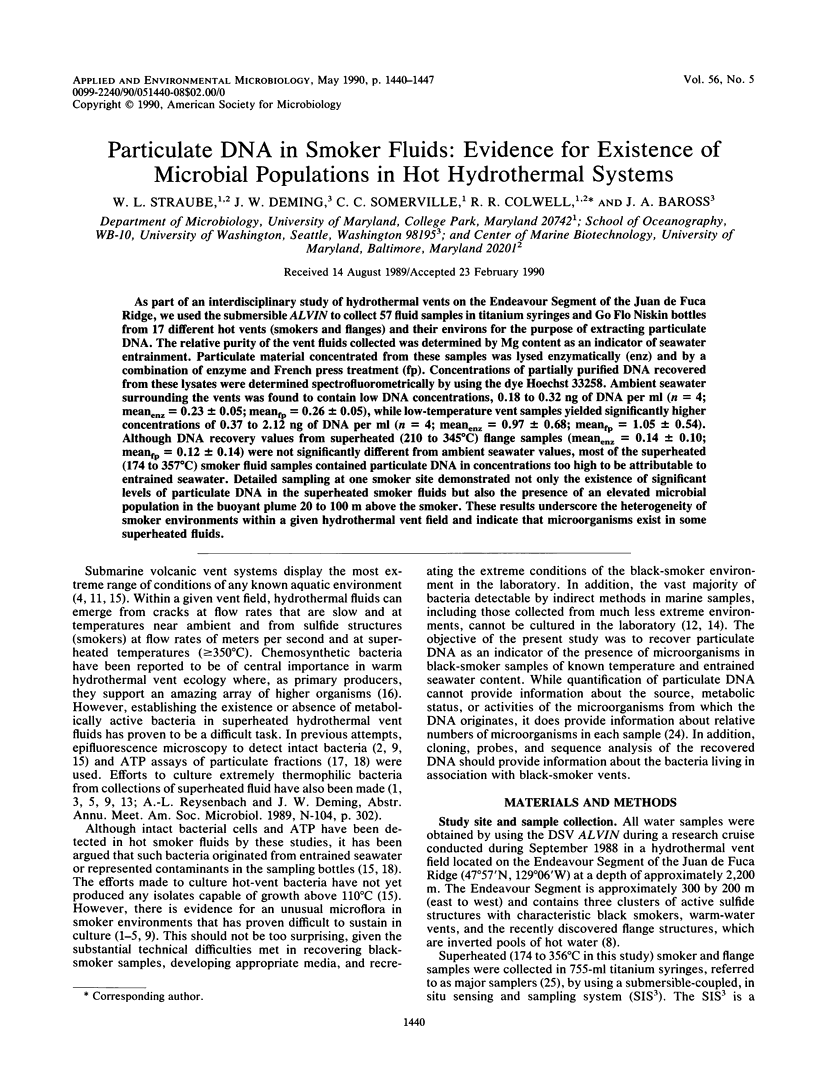Abstract
As part of an interdisciplinary study of hydrothermal vents on the Endeavour Segment of the Juan de Fuca Ridge, we used the submersible ALVIN to collect 57 fluid samples in titanium syringes and Go Flo Niskin bottles from 17 different hot vents (smokers and flanges) and their environs for the purpose of extracting particulate DNA. The relative purity of the vent fluids collected was determined by Mg content as an indicator of seawater entrainment. Particulate material concentrated from these samples was lysed enzymatically (enz) and by a combination of enzyme and French press treatment (fp). Concentrations of partially purified DNA recovered from these lysates were determined spectrofluorometrically by using the dye Hoechst 33258. Ambient seawater surrounding the vents was found to contain low DNA concentrations, 0.18 to 0.32 ng of DNA per ml (n = 4; meanenz = 0.23 ± 0.05; meanfp = 0.26 ± 0.05), while low-temperature vent samples yielded significantly higher concentrations of 0.37 to 2.12 ng of DNA per ml (n = 4; meanenz = 0.97 ± 0.68; meanfp = 1.05 ± 0.54). Although DNA recovery values from superheated (210 to 345°C) flange samples (meanenz = 0.14 ± 0.10; meanfp = 0.12 ± 0.14) were not significantly different from ambient seawater values, most of the superheated (174 to 357°C) smoker fluid samples contained particulate DNA in concentrations too high to be attributable to entrained seawater. Detailed sampling at one smoker site demonstrated not only the existence of significant levels of particulate DNA in the superheated smoker fluids but also the presence of an elevated microbial population in the buoyant plume 20 to 100 m above the smoker. These results underscore the heterogeneity of smoker environments within a given hydrothermal vent field and indicate that microorganisms exist in some superheated fluids.
Full text
PDF







Selected References
These references are in PubMed. This may not be the complete list of references from this article.
- Deflaun M. F., Paul J. H., Davis D. Simplified method for dissolved DNA determination in aquatic environments. Appl Environ Microbiol. 1986 Oct;52(4):654–659. doi: 10.1128/aem.52.4.654-659.1986. [DOI] [PMC free article] [PubMed] [Google Scholar]
- Deming J. W., Baross J. A. Solid Medium for Culturing Black Smoker Bacteria at Temperatures to 120 degrees C. Appl Environ Microbiol. 1986 Feb;51(2):238–243. doi: 10.1128/aem.51.2.238-243.1986. [DOI] [PMC free article] [PubMed] [Google Scholar]
- Ferguson R. L., Buckley E. N., Palumbo A. V. Response of marine bacterioplankton to differential filtration and confinement. Appl Environ Microbiol. 1984 Jan;47(1):49–55. doi: 10.1128/aem.47.1.49-55.1984. [DOI] [PMC free article] [PubMed] [Google Scholar]
- Jannasch H. W., Mottl M. J. Geomicrobiology of deep-sea hydrothermal vents. Science. 1985 Aug 23;229(4715):717–725. doi: 10.1126/science.229.4715.717. [DOI] [PubMed] [Google Scholar]
- Paul J. H., Myers B. Fluorometric determination of DNA in aquatic microorganisms by use of hoechst 33258. Appl Environ Microbiol. 1982 Jun;43(6):1393–1399. doi: 10.1128/aem.43.6.1393-1399.1982. [DOI] [PMC free article] [PubMed] [Google Scholar]
- Somerville C. C., Knight I. T., Straube W. L., Colwell R. R. Simple, rapid method for direct isolation of nucleic acids from aquatic environments. Appl Environ Microbiol. 1989 Mar;55(3):548–554. doi: 10.1128/aem.55.3.548-554.1989. [DOI] [PMC free article] [PubMed] [Google Scholar]


